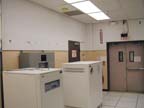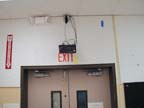A Locking Pathway

While it might seem a daunting task to make the transition to total integrated access control, there’s a comfortable pathway.
The first priority for any access control plan is to establish control over the origination and duplication of mechanical keys. Whether it’s a storage closet, research lab, computer room, office or records room, a programmable locking system can eliminate the distribution of keys. If the need is to provide controlled access to multiple users sharing access to multiple openings, programmable electronic locks and trims are the first step in a migration from mechanical key systems to fully electronic access control.
Keypad locks are usually limited to a 17- or 19-code capacity, while electronic locking systems are also at a price point of mechanical single-code locks. With such devices, staff can quickly program up to 120 individual user codes, right at the keypad. Administrators can add or delete users in about 10 seconds. Electronic programmable locking systems operate on four AA alkaline batteries, which provide 80,000-plus cycles – approximately three years of use.

provide audit-trail capability and time-based scheduling for restricting access.
Because codes can be added or deleted, security can be enhanced by increasing the frequency with which codes are changed, while also cutting down on the labor time and cost to accomplish this. This also helps reduce liability; the moment an employee who knows an access code leaves the company, security is at risk if steps to prevent future access are not taken. As soon as an employee quits the company or a new employee joins the organization, administrators can immediately delete an old code/credential or add a new code/credential at the keypad to maintain increased security. This prevents the building from having to continually re-key a lock whenever an employee leaves or mechanical keys go missing.
South Carolina’s Rock Hill School District No. 3 employs these types of electronic locks to protect students, teachers and staff on several of its 33 campuses. Currently, the school district has about 25 electronic locks installed at eight campuses, used to secure outside doors at elementary schools, lock buildings when teachers and students go outside for recess, and ensure that doors aren’t left propped open. An electronic lock is also installed on a lab to protect expensive equipment.
“I’ve worked very hard to get electronic locks in the district, and so far everyone is really liking them,” said Mike Robbins, a locksmith for the Rock Hill School District for the past 18 years. “The initial cost may be more, but you spend more money rekeying a facility if someone loses a key. Plus, you can change the code and your facility is secure again in a matter of minutes. When you use mechanical keys, you have to go around and rekey all the doors. The electronic locks are easy to program and use and require almost no maintenance.”

Computer-managed systems
The first step in an intelligent migration from mechanical locks to total integrated access control can involve computer-managed (CM) locking systems. CM locking systems offer many of the same benefits as a networked, hardwired system, without the higher cost and additional care associated with routing network cable when retrofitting an existing facility with electronic access control. These standalone locks are networked through software to provide audit-trail capability and time-based scheduling for restricting access.Current software can manage most any type of credential, while controlling the locks, access trim and offline hard-wired controllers, which manage strikes and magnets, from a laptop or PDA. New users, access points and access privileges can be entered into the system in seconds. They also provide an audit trail capability.
One CM lock is currently installed on a fitness room for teachers and students. Teachers are given the code, so students can only access it when a teacher is present. Eventually teachers will be able to use their ID badges to access the lock. The district plans to install more CM locks that will work with proximity cards.
Similarly, Canadian Blood Services is using CM locking systems to restrict access to high-security areas of its Vancouver facility. “Our building is a very tight security building,” said Dan Lee, facilities coordinator for the company’s British Columbia and the Yukon areas. “Only a certain number of staff are allowed to go through the doors secured with the CM locks.”
Lee manages 15 CM locks that control access to the lab area, the administration areas, the archives and a supply warehouse. The center employs about 200 people and only a handful of staff members are allowed access to high security areas. The company uses HID proximity cards with the battery-operated, standalone CM locking systems. Using just one proximity card credential, staff members can be granted access to any combination, or none, of the high-security areas. Prior to installing the CM locks, the Vancouver facility used mechanical keys.
“The locks are really easy to program,” said Lee, who uses a laptop computer and LockLink software, but plans to purchase a handheld computer or PDA in the near future. The company also has plans to add more CM locks at the Vancouver location in the coming months, as the facility undergoes a renovation.
System operators can control both users and access points based on time of day, day of week, credential needed and/or period of time. Reports show audit trails retrieved, access privileges granted and time functions established by either the user or door. An administrator goes to the opening, plugs in the interface to the locking system right at the door, and uploads new access instructions to the lock while downloading audits of who has been through the door and when. This function can also be used to assign access rights by credential and/or time.
Selectable functions include time zones, time activation and expiration, auto unlock time scheduling, first-person-in and holiday scheduling. A variety of reports are available to help manage a facility more efficiently, including audit trail data, access privileges data, and time function schedules by user or door.
Whatever the credential, administrators can perform various functions including momentary and maintained access, lockout, one-time use, supervised and linked access, in which a code must be used in tandem with a credential such as at a bank’s ATM. Linked access reduces the probability of lost or stolen credentials from providing unauthorized access.
Third parties
Beyond CM locking systems are the hardwired locks, which let users use a CM-type lock to monitor door openings with their own existing, third party access control panels and software. Such an open architecture platform connects the door lock to a panel interface board (PIB), and subsequently any present access control panel. There is no need for separate components or multiple manufacturers’ products. Users access the lock with either magnetic stripe or HID proximity cards.As a result, credential data and door status information required by the access control panel, such as door position or request-to-exit status, are passed via RS-485 communication from the lock to the panel via the PIB provided with the locks. The access control panel maintains control of the lock status and status indication on the locks as it does with present electric strike or electromagnetic locking systems. All monitoring is captured at the remote station.
The business case for deploying the wireless systems in networked openings is quite compelling, given an inherently lower installed cost than an online access control system. Wireless systems use less hardware and install five to ten times faster than those that require running cable. Usually, a wireless system can integrate into existing access control systems while allowing employees to continue to use their existing keys or ID credentials.
When planning the move from the mechanical world to electronic, networked or wireless locking systems, the transition does not have to take place overnight, nor does not need to be total. Adding electronic locking systems to access points as time and budgets allow could be a sensible migration plan for most any organization.
Looking for a reprint of this article?
From high-res PDFs to custom plaques, order your copy today!





